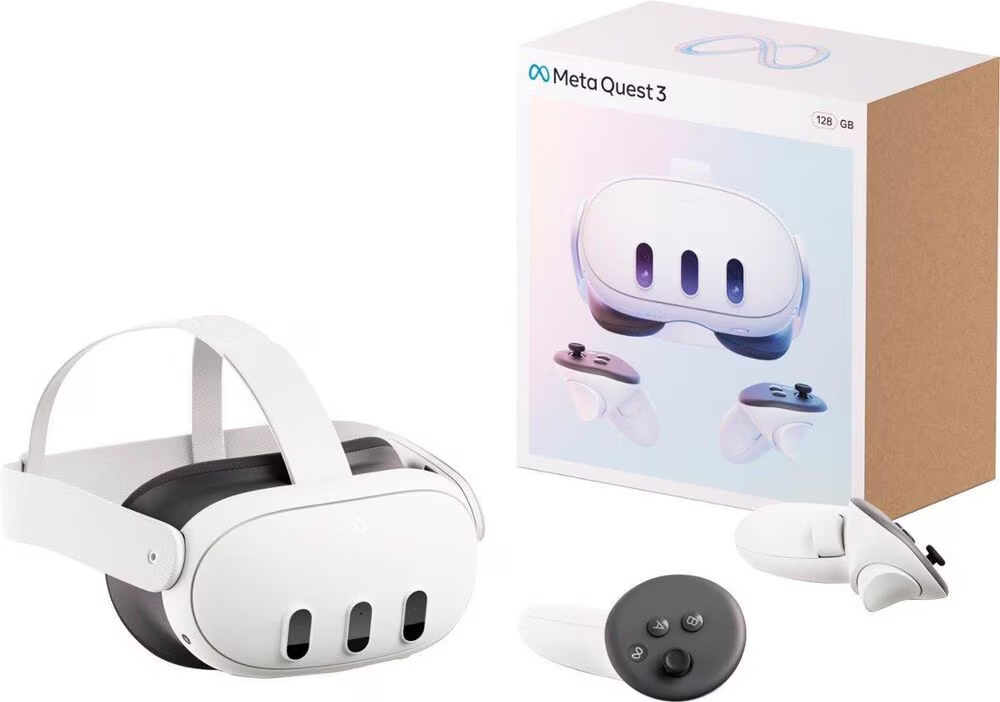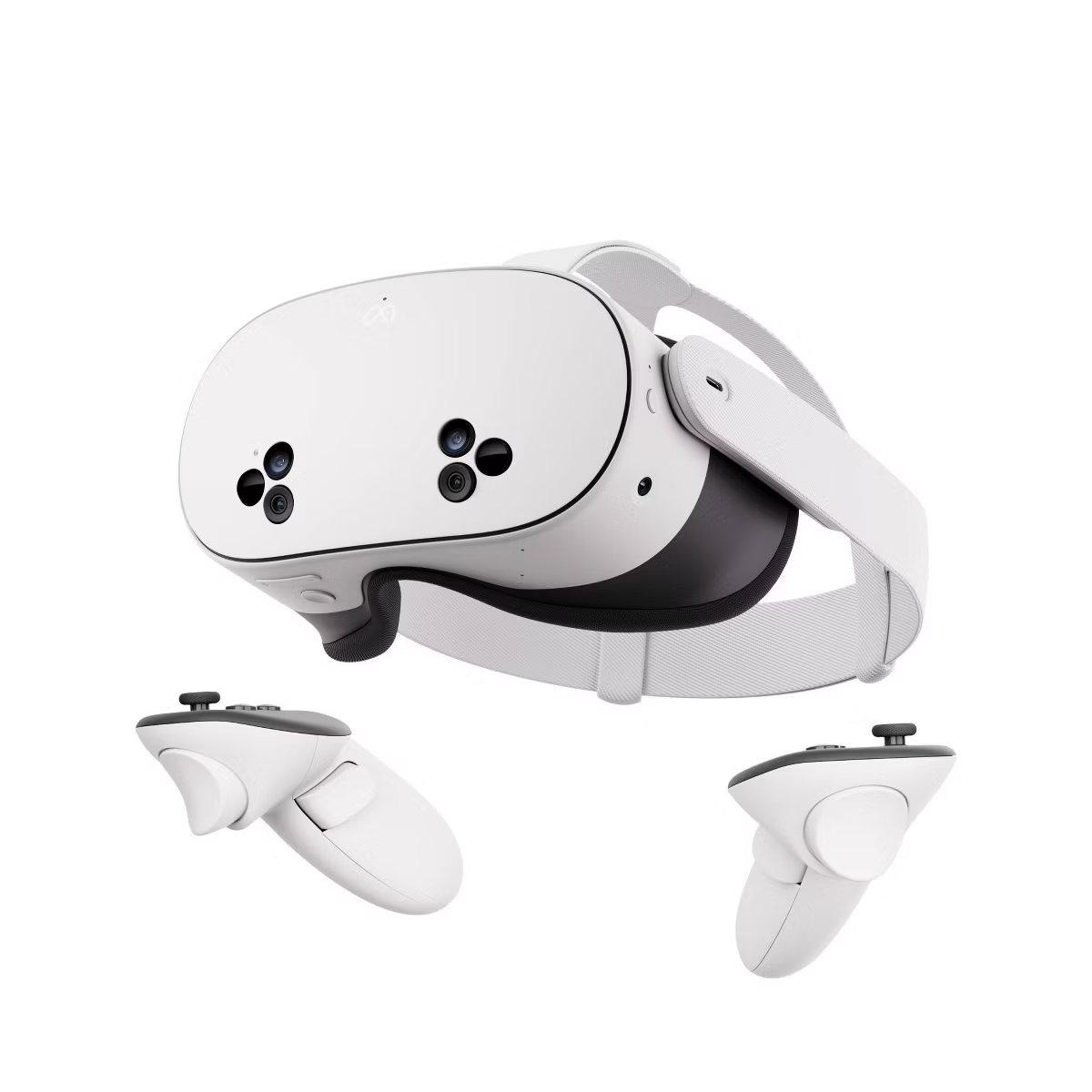
This review was originally published in 2020 for the Oculus Quest (first-gen). It has been fully updated for 2025 to cover the latest models (Meta Quest 3 and Quest 3S), with fresh hands-on impressions, buying advice, and new comparison data.
IN A HURRY? CHECK OUT META QUEST 3 TOP PROS:

- High-res LCD + pancake lenses
- Color passthrough mixed reality
- Solid performance & comfort
Note: If you’re here from our 2019 Oculus Quest review, this is the up-to-date guide. We keep that page as a historical archive and link important updates here.
CONTENTS
- Quick Summary
- Who should buy the Quest 3?
- Display, optics & comfort
- Tracking, hand input & mixed reality
- Performance, battery & thermals
- Audio, mic & streaming
- Ecosystem: games, apps & accessories
- Quest 3S vs Quest 3: what’s different?
- Quest 3 vs Quest 2 vs Quest Pro (comparison table)
- Setup tips, comfort mods & safety
- FAQ
- Verdict
Quick Summary
| IMAGE | PRODUCT | DETAILS | |
|---|---|---|---|
 |
Our #1 Choice
Meta Quest 3 |
|
Shop Now |
 |
Meta Quest 3S |
|
See lineup |
Who should buy the Quest 3?
Buy the Quest 3 if you want the best all-around standalone VR & mixed-reality headset under $500, with the widest consumer app library and strong hand/controller tracking. It’s the mainstream pick for gaming, fitness (see our VR accessories guide), social VR, creative tools, and MR experiments.
Consider waiting or going 3S if price is the main decider and you’re okay with a slightly pared-back experience for casual games, media and light MR. (We compare them in detail below.)
PCVR users can still use Link/Air Link to play SteamVR and Rift titles. If you’re thinking full-body or haptics, start with our full-body tracking sets and VR shoes roundups.
Display, optics & comfort
The Quest 3 uses pancake lenses (a big step up from the Fresnels in Quest 2), delivering a wider “sweet spot,” fewer god-rays, and a slimmer front profile. The LCD panel resolution is high enough that text in productivity apps and UI elements is far clearer than previous gen. Most titles now target higher refresh modes, and motion clarity feels excellent in rhythm and action games.
IPD adjustment is handled with physical steps and on-screen guidance; set it precisely and you’ll notice crisper edges and less eyestrain. The default soft strap is okay for short sessions; for longer play and better weight distribution, we recommend an elite-style strap with a rear cradle or battery pack (doubles playtime and balances the front weight). See our comfort mods in Setup tips.

Tracking, hand input & mixed reality
Tracking is where Quest 3 shines. The inside-out system is fast and robust, and the Touch Plus controllers drop the tracking ring, feel lighter, and include stronger haptics. Hand tracking has matured a lot: menus, media, casual games, and MR apps are now very usable without controllers, and gestures feel natural once your lighting is reasonable.
Color passthrough MR makes a big difference. You can place windows on your real desk, play mixed-reality mini-games that interact with walls and furniture, and do quick tasks without taking the headset off. It’s still not “see-through glasses,” but it’s the first mass-market headset where passthrough is good enough to be genuinely useful.
Best practices: keep rooms moderately lit (avoid pitch-black or facing bright windows), clear your guardian area, and re-scan if you rearrange furniture.
Performance, battery & thermals
Daily use feels snappy: faster app loads, fewer dips in complex scenes, and better MR compositing. Most native titles hold smooth framerates, and PCVR over Wi-Fi 6/6E (or better) is great once your router is configured. Battery life depends on refresh rate and MR usage—expect ~2 hours of active gaming; more with a rear battery strap.
Audio, mic & streaming
On-band integrated speakers are convenient, with decent clarity and spatial cues (expect bass roll-off). For music/rhythm games or late-night sessions, plug in 3.5mm earbuds or pair low-latency Bluetooth if supported by your setup. The mic is perfectly fine for party chat and social apps.
Creators: you can capture gameplay natively or stream via PC. For clean audio and overlays, PC streaming tools still give the most control.
Ecosystem: games, apps & accessories
Quest’s store remains the deepest for standalone VR. Core hits (Beat Saber, Population: One, Walkabout, Supernatural/FitXR, Golf+, Asgard’s Wrath 2) run great; mixed-reality titles are growing, from spatial puzzle games to desk-anchored creativity tools. PCVR expands the library further via SteamVR.
Accessories we like (see our guides):
- Elite-style straps & battery backs — better comfort + extra playtime
- Prescription or wider FOV facial interfaces — clarity + hygiene
- Play-space mats & cable management — safer guardian boundaries
- Full-body tracking add-ons (PCVR) — for VTubing & mocap
- Travel cases — protect the lenses when you’re on the go
Quest 3S vs Quest 3: what’s different?
TL;DR: The 3S slots in as a budget-friendlier refresh of the Quest 3 platform. You get access to the same core store and most MR experiences, but trade a few niceties (optics/fit/features) to hit a lower price point. If you care about the best visual clarity and MR quality, grab the Quest 3; if you mainly want casual gaming, media, and simple MR at the lowest cost, the 3S makes sense.
- Optics & clarity: Quest 3’s lenses deliver a bigger sweet spot and crisper text at the edges. 3S is fine for games and media; productivity feels better on 3.
- Mixed reality: Both handle passthrough; Quest 3 produces cleaner, more color-accurate views.
- Comfort & build: Strap options vary; Quest 3 has broader third-party support right now.
- Price: 3S is positioned to be kinder on the wallet.
Bottom line: If your budget allows, the Quest 3 is the “no regrets” pick. If you’re price-sensitive or buying multiple headsets for family, the 3S is the sensible entry.
Quest 3 vs Quest 2 vs Quest Pro (at a glance)
| Headset | Optics | Passthrough/MR | Comfort | Who it’s for |
|---|---|---|---|---|
| Quest 3 | High-res LCD + pancake lenses; wide sweet spot | Best consumer color passthrough MR | Good stock; excellent with elite/battery strap | Most people; gaming, fitness, MR, PCVR |
| Quest 2 | Lower-res LCD + Fresnel; smaller sweet spot | Basic greyscale passthrough | Light but front-heavy; strap upgrade recommended | Bargain hunters; secondary headset |
| Quest Pro | Great lenses & controllers; pro-leaning fit | Strong MR; enterprise-tilted | Forehead-pad design; balanced | Pros/creators who need specific features |
Differences in Play: Who Each Headset Is Best For
While the Quest 3 and Quest 3S share the same platform and app library, the experience of actually playing feels a little different:
- Quest 3 — Best for gamers who want sharp visuals in text-heavy or graphically detailed titles (like RPGs, simulators, or productivity apps). The wider sweet spot and higher clarity make longer sessions more comfortable. Its mixed reality passthrough is also much cleaner, so creators, fitness fans, and MR experimenters benefit most here.
- Quest 3S — Suited for casual play, family use, and social VR. Fast-action games, rhythm titles like Beat Saber, or party apps run well, and the lower entry price makes it a smart choice if you’re buying multiple headsets or don’t need premium optics.
In short: go with Quest 3 if you want the best experience across genres or if you plan to use MR apps a lot. Pick the Quest 3S if you mainly want an affordable, accessible way to enjoy VR games and social worlds without stretching your budget.
Setup tips, comfort mods & safety
- Guardian & lighting: Moderate, even lighting avoids tracking dropouts. Face away from bright windows; add a floor mat for spatial awareness.
- Dial your IPD: Use the on-screen guide, then micro-adjust until text looks crisp edge to edge.
- Balance the front weight: Elite/battery strap = longer sessions, less face pressure.
- Care for lenses: Always use the included separator in the case and avoid sunlight; pancake lenses can still be damaged by focused rays.
- PCVR streaming: For Air Link, use Wi-Fi 6/6E router in the same room; wired Link is still the latency king for sim racers and rhythm purists.
Frequently Asked Questions
Is Quest 3 worth it over Quest 2?
Yes. Between optics, passthrough MR, performance, and comfort potential, it’s a substantial generational leap—especially if you value MR or read a lot of text.
Can I play PCVR titles like Half-Life: Alyx?
Yes, via Meta Link (USB-C) or Air Link over a strong Wi-Fi network. See our room setup guide for best practices.
How good is the hand tracking?
For menus, media, casual games, drawing, and MR tools, it’s great. For fast, competitive games you’ll still prefer controllers.
Will my Quest 2 games/apps carry over?
Yes—your library follows your account. Many titles also push higher settings on Quest 3 automatically.
Which strap should I buy first?
If you do longer sessions, go straight to a rigid rear-cradle strap—ideally one with a battery. It’s the single biggest comfort upgrade.
Verdict
The Meta Quest 3 is the best mainstream VR/MR headset you can buy in 2025. It nails the essentials—clarity, tracking, content—and makes mixed reality useful, not just a tech demo. If you’re upgrading from Quest 2 or entering VR for the first time, this is the “no-brainer” pick. The 3S exists to lower the price of entry; choose it only if budget is paramount. Otherwise, get the Quest 3 and don’t look back.
YOU MIGHT ALSO LIKE:
Best VR Headsets
Best VR Accessories
How To Set Up A VR Room
Best Full-body VR Tracking Sets
Best VR Shoes



